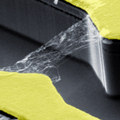Speed detection of electrons in nanoscale photodetectors:
Ultra fast photodetectors out of carbon nanotubes
07.03.2011, Press releases
Carbon nanotubes are promising elements for optoelectronic components. However so far there were no electronic methods to analyze the ultra fast optoelectronic dynamics of the nanotubes. A team of physicists headed by Professor Alexander Holleitner from the Technische Universitaet Muenchen (TUM) has now come up with a new method to directly measure the dynamics of photo-excited electrons in nanoscale photodetectors.
Carbon nanotubes have a multitude of unusual properties which make them promising candidates for optoelectronic components. However, so far it has proven extremely difficult to analyze or influence their optic and electronic properties. A team of researchers headed by Professor Alexander Holleitner, a physicist at the Technische Universitaet Muenchen and member of the Cluster of Excellence Nanosystems Munich (NIM), has now succeeded in developing a measurement method allowing a time-based resolution of the so-called photocurrent in photodetectors with picosecond precision.
“A picosecond is a very small time interval,” explains Alexander Holleitner. “If electrons traveled at the speed of light, they would make it almost all the way to the moon in one second. In a picosecond they would only cover about a third of a millimeter.” This new measurement technique is about a hundred times faster than any existing method. It allowed the scientists headed by Professor Alexander Holleitner to measure the precise speed of electrons. In the carbon nanotubes the electrons only cover a distance of about 8 ten-thousandths of a millimeter or 800 nanometers in one picosecond.
At the heart of the photodetectors in question are carbon tubes with a diameter of about one nanometer spanning a tiny gap between two gold detectors. The physicists measured the speed of the electrons by means of a special time-resolved laser spectroscopy process – the pump-probe technique. It works by exciting electrons in the carbon nanotube by means of a laser pulse and observing the dynamics of the process using a second laser.
The insights and analytic opportunities made possible by the presented technique are relevant to a whole range of applications. These include, most notably, the further development of optoelectronic components such as nanoscale photodetectors, photo-switches and solar cells.
The studies were funded by the German Research Foundation (Cluster of Excellence Nanosystems Initiative Munich, NIM) and the Center for NanoScience (CeNS) at Ludwig-Maximilians-Universitaet Muenchen. Further contributions to the publication came from physicists of the University of Regensburg (Germany) and the Swiss Federal Institute of Technology, Zurich.
Original publication:
Time-Resolved Picosecond Photocurrents in Contacted Carbon Nanotubes,
Leonhard Prechtel, Li Song, Stephan Manus, Dieter Schuh, Werner Wegscheider, Alexander W. Holleitner, Nano Letters 2011, 11 (1), pp 269–272, DOI: 10.1021/nl1036897
Contact:
Prof. Alexander W. Holleitner
Technische Universitaet Muenchen
Walter Schottky Institute – Center for Nanotechnology and Nanomaterials
Am Coulombwall 4a, 85748 Garching, Germany
Tel.: +49 89 289 11575 – Fax: +49 89 289 11600
E-Mail – Internet
Kontakt: presse@tum.de
More Information
| 110307_PhotoCurrent_PW_DE.pdf |
Druckversion der Presseinformation (DE),
(Type: application/pdf,
Size: 131.6 kB)
Save attachment
|
|
| 110307_PhotoCurrent_PW_EN.pdf |
Printable version of The press release (EN),
(Type: application/octetstream,
Size: 116.2 kB)
Save attachment
|




